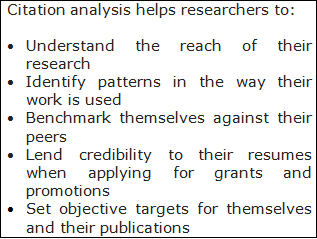The landscape of science and research is rapidly evolving. Gone are the days when all members of a university department would celebrate the successful publication of a colleague’s paper.1 Earlier, scientists would simply consider the number of papers they had published as a measure of their academic standing. Today, the focus is increasingly shifting from whether a researcher has published a paper to where he/she has published it and the impact that piece of research has on the scientific community and the world at large.2
How can you measure the quality of a research paper? More importantly, how can you determine whether your research is making an impact and is considered important? An objective way is through citation analysis.

Why count citations in the first place? The list of references directing readers to prior relevant research is considered a fundamental part of any research paper.3 A reference or citation is a form of acknowledgment that one research paper gives to another. Research is additive—scientists build on past work to discover new knowledge. To identify gaps in existing research and choose a research topic, researchers read the relevant published research and use this existing material as a foundation for arguments made in their own research papers.
11 reasons to cite previous work
- To direct readers to an authentic source of relevant information
- To help other researchers trace the genealogy of your ideas
- To acknowledge pioneers and peers
- To direct readers to previously used methods, and equipment
- To criticize or correct previous work
- To substantiate your claims and arguments with evidence
- To show that you have considered various opinions in framing your arguments
- To highlight the originality of your work in the context of previous work
- To guide other researchers in their work
- To build your credibility as an author
- Finally, because not citing sources can amount to plagiarism4
What are the various citation-based metrics?
Citation analyses can be grouped according to some broad types based on who/what is being evaluated.
- Ranking journals: Journals are ranked by counting the number of times their papers are cited in other journals. Journal-level metrics are generally meant to serve as an indicator of journal prestige. The most well known of these is the journal impact factor, from Journal Citation Reports®(a product of Thomson Reuters). The journal impact factor is calculated as the average number of citations all articles in a journal receive over a specific period of time.5
- Ranking researchers: Various citation metrics are now used for this purpose. Researchers are ranked by counting the number of times their individual papers are cited in other published studies. These metrics are also used to evaluate researchers for hiring, tenure, and grant decisions. A researcher-level metric that is gaining popularity is the h index,6 which is calculated by considering a combination of the number of papers published by a researcher and the number of citations these papers have received.
- Ranking articles: Article-level citation counts may provide an accurate evaluation of the quality and impact of a specific piece of work, regardless of the author. Unfortunately though, such metrics are rarely considered because obtaining these data is tedious and time-consuming.7
- Ranking universities and countries: There are databases that rank universities and countries by considering their overall research output through criteria such as citable documents, citations per document, and total citations. These metrics help determine which universities and countries have the most and/or best scientific output. For example, Scimago Research Group (http://www.scimago.es/ ) releases annual reports of institution- and country-wise rankings.
How can citation analysis help you?
Researchers today are faced with increasing pressure to get published. Academic departments are expected to meet specific levels of publication output. Clearly, there is a lot at stake in the assessment of research quality for both individuals and institutions. Given this, governments, funding agencies, and tenure and promotion committees are looking toward simple and objective methods to assess increasing research volumes in the least possible time. To this end, they are turning more and more to citation analysis for objective parameters of impact assessment.

Pitfalls of citation analysis
When using citation analysis, it is important to bear in mind some of its limitations3,7:
- It overlooks the disparity in discipline-wise citation rates, that is, the fact that citation patterns differ among disciplines and over time.
- It ignores the fact that certain manuscript types such as letters and case reports offer inadequate scope for citation and typically have short reference lists. The sentiment of the citation is not considered; that is a negative citation (one used to refute a prior claim) is given as much merit as a positive citation (one used to further the claim being made). So even a paper that has been cited simply to discredit it can work to the author’s advantage in citation analysis.
- It does not account for author contribution on papers with multiple authors: such citations are as meritorious as those to single-author papers. Citation analysis attributes equal importance to all authors of a paper, regardless of their individual contribution.
Thus, sole reliance on citation data provides an incomplete understanding of research. Although citation analysis may be simple to apply, it should be used with caution to avoid it coming under disrepute through uncritical use.3 Ideally, citation analysis should be performed to supplement, not replace, a robust system of expert review to determine the actual quality and impact of published research.8
Future of citation analysis
Given the shift to online interfaces by more and more journals and repositories, digital information is now available at a few clicks. With the advent of linking tools and digital archives of research papers, scientific literature is more easily retrievable than ever before. Therefore, it is only to be expected that the population of researchers turning to citation data will continue to grow. In such a scenario, researchers cannot afford to undermine the importance of citation analysis.
So next time you are preparing for a promotion or applying for a new position, consider using citation analysis as a means to bolster your eligibility. Use the citation count feature offered by online databases like Web of Science to compile your citation data and employ multiple citation metrics to highlight your research output.
Bibliography











